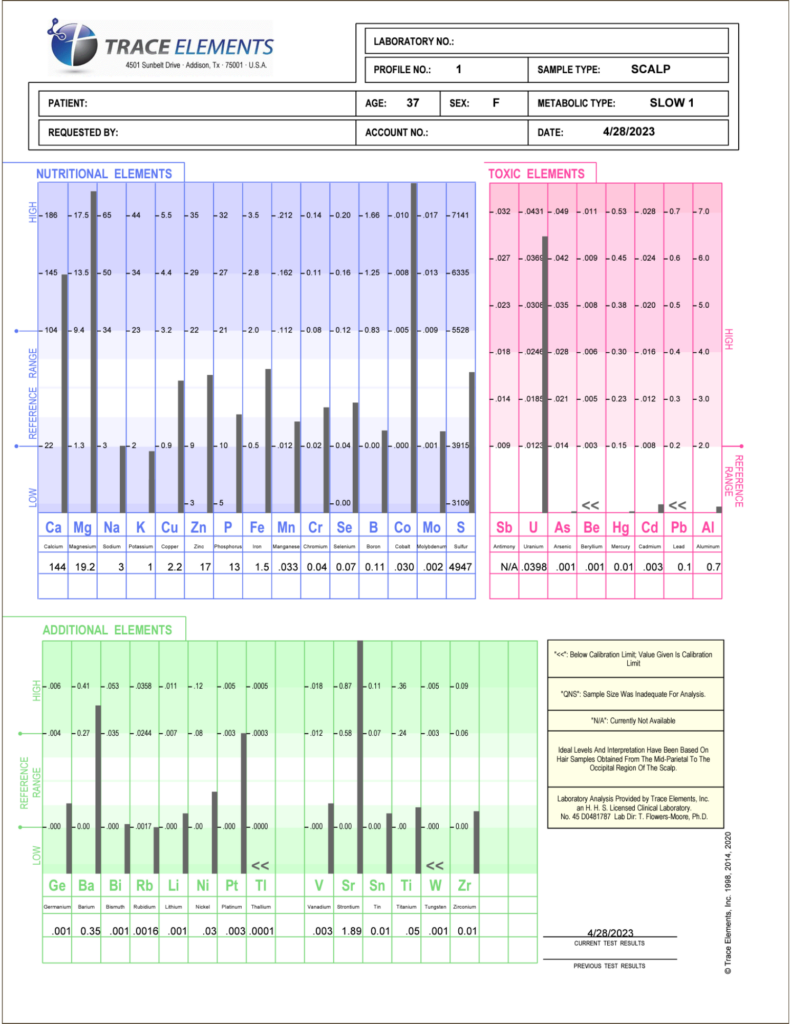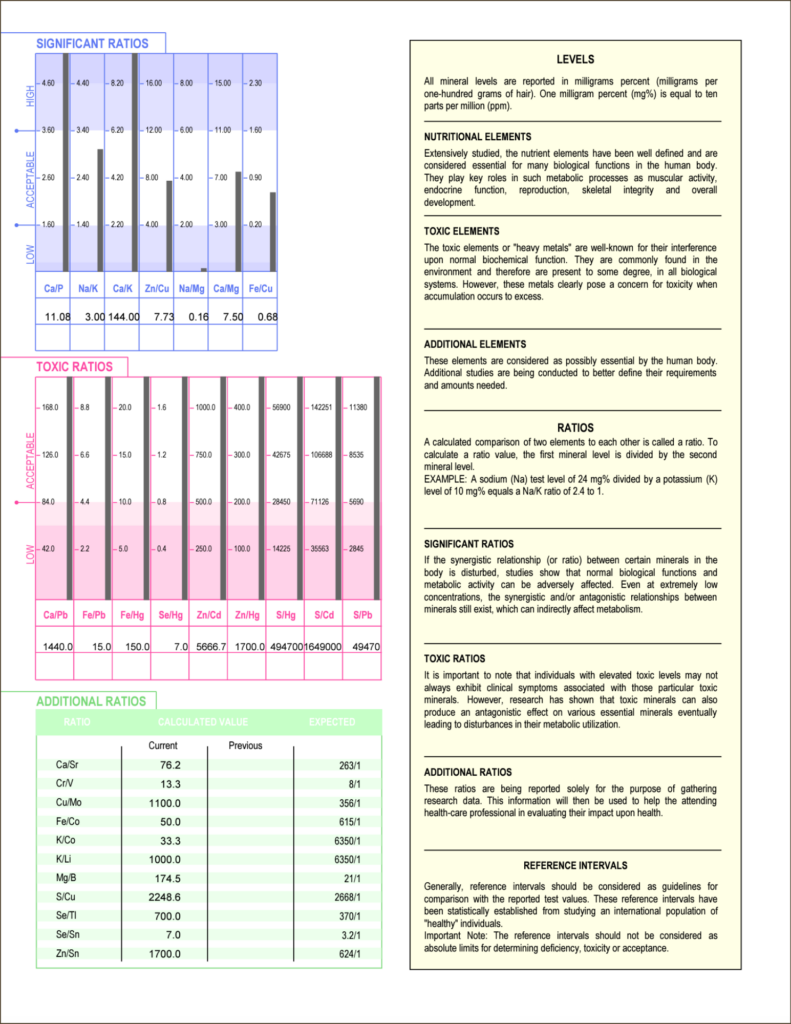October 4, 2023
HTMA stands for Hair Tissue Mineral Analysis. It is a diagnostic test that analyzes a small sample of hair to assess the mineral and heavy metal content within the body.
The HTMA process involves collecting a small hair sample, typically taken from the scalp, and sending it to a specialized laboratory for analysis. The laboratory uses sophisticated techniques, such as inductively coupled plasma mass spectrometry (ICP-MS) or atomic absorption spectrophotometry, to measure the mineral and heavy metal levels present in the hair sample.
The analysis of the hair sample provides information about the body’s mineral imbalances, nutrient deficiencies, and excess heavy metal accumulation. It can help identify deficiencies in essential minerals like calcium, magnesium, zinc, iron, and copper, as well as detect toxic elements such as lead, mercury, arsenic, cadmium, and aluminum.
The HTMA can provide insights into a person’s overall health status, including their metabolic rate, energy production, adrenal and thyroid function, and potential exposure to environmental toxins. It is often used in complementary and alternative medicine practices as a tool for personalized health assessments and nutritional guidance. The HTMA helped guide my personal health journey after 2 bad mold exposures in 2021.
It’s important to note that HTMA has its critics as well. Some medical professionals argue that the scientific evidence supporting the use of HTMA for health assessment and treatment decisions is limited. They emphasize that the interpretation of HTMA results requires caution and should be done in conjunction with other diagnostic tests and clinical evaluations. The HTMA is by no means a miracle test that provides all the answers to all your problems, but it can and does act like a roadmap to better health.
HTMA Interpretation
Interpreting HTMA results is not as simple as glancing at a report, supplementing for minerals that look low and decreasing intake of minerals that look high.
HTMA interpretation involves a systematic analysis of nutritional mineral levels, heavy metal levels, and significant and toxic ratios; it requires expertise and a deep understanding of the body’s complex mineral interactions. A qualified practitioner’s interpretation yields significant finding regarding all of the following:
- Mineral Imbalances: HTMA can identify imbalances or deviations in mineral levels, including essential minerals like calcium, magnesium, potassium, sodium, zinc, iron, copper, and manganese. It can indicate if there are deficiencies, excesses, or losses of these minerals, which may impact overall health and bodily functions.
- Nutrient Deficiencies: By assessing mineral levels, HTMA can indicate potential nutrient deficiencies. Adequate mineral levels are important for various physiological processes, and imbalances may indicate a need for dietary adjustments and/or targeted supplementation.
- Heavy Metal Toxicity: HTMA can detect the presence of toxic heavy metals such as lead, mercury, arsenic, cadmium, aluminum, and others. These toxic elements can accumulate in the body over time through various sources, such as environmental exposure, contaminated food or water, and certain lifestyle choices.
- Metabolic Activity/Patterns: HTMA can provide insights into metabolic patterns and overall cellular activity. It can assess energy production, thyroid and adrenal function, and the body’s response to stress.
- Oxidative Stress: HTMA may offer some indications of oxidative stress levels within the body. Oxidative stress occurs when there is an imbalance between the production of harmful free radicals and the body’s ability to neutralize them, potentially leading to cell damage and various health issues.
- Environmental Exposure: By detecting heavy metals, HTMA can provide information about a person’s potential exposure to environmental toxins. This can be particularly relevant for individuals living or working in environments with higher levels of heavy metal pollution.
For additional information on the HTMA, see my blog posts about minerals, toxic heavy metals, and HTMA ratios.
Again, it is important to note that while HTMA provides valuable insights, it should be interpreted alongside other clinical data, health history, lifestyle assessments, and symptoms/complaints. Consulting with a qualified practitioner experienced in HTMA interpretation can help to accurately understand and integrate the results into a comprehensive healing protocol.


Sample HTMA Results Report
Importance of Working with an HTMA Practitioner
Interpreting HTMA results isn’t a one-size-fits-all process. The interpretation requires a deep understanding of biochemistry, physiology, and mineral interactions. Here’s why working with an HTMA practitioner is essential:
- Expertise: HTMA practitioners are trained and experienced in understanding the nuances of mineral imbalances and their implications on health. They can accurately assess your results in the context of your unique health profile.
- Personalized Guidance: Practitioners can provide tailored recommendations for diet, lifestyle, and supplements based on your HTMA results. This personalization is crucial for addressing your specific health needs.
- Safety: An HTMA practitioner ensures that any recommendations for mineral supplementation are safe and appropriate for you, preventing the risk of overcorrection or exacerbating imbalances.
- Holistic Health Assessment: HTMA practitioners can integrate your HTMA results with other clinical data, providing a more comprehensive understanding of your health and guiding a holistic approach to wellness.
Get Your HTMA Results and Recommendations
HTMA is a valuable tool for understanding your body’s mineral status and identifying potential health imbalances. However, the true power of HTMA lies in its interpretation and subsequent healing recommendations.
If you want a personalized roadmap to less fatigue and more energy, less aches and pains and more vitality, less cravings and more satiation, less disease and more healthy living, then the HTMA is for you.

Leave a comment